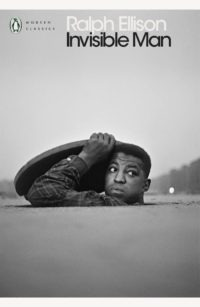Harsh as a cry of terror in their quietness
 Invisible Man
Invisible Man
by Ralph Ellison
I have been meaning to read this for years, and especially so since I added it to two of my reading lists: Classics Club and the Luke Cake Reading List. I finally bought a copy after seeing the Gordon Parks photography project of the same name in Berlin last year (Parks and Ellison worked together on the project for LIFE magazine), which was a really moving experience.
The novel is also moving, but equally brutal and shocking. It opens and closes (aside from the slightly abstract, essayistic prologue and epilogue) with its most shocking scenes. The un-named narrator starts out as a successful scholar whose family can’t afford to send him to college. His one chance is to impress the local rotary club – i.e. powerful rich white men. At the club he finds himself in a group of black young men who are stripped to their underwear and forced to fight each other while blindfolded. Afterward they are made to scrabble on the floor for their pay. It’s upsetting, humiliating, dehumanising, and the outcome is that the narrator is given a scholarship to a black-only college. It seems that his life is set.
“The wheel felt like an alien thing in my hands as I followed the white line of the highway. Heat rays from the late afternoon sun arose from the gray concrete, shimmering like the weary tones of a distant bugle blown upon still midnight air. In the mirror I could see Mr Norton staring out vacantly upon the empty fields, his mouth stern, his white forehead livid…And seeing him I felt the fear balled coldly within me unfold. What would happen now?”
Except we know from the prologue that things do not work out for our hero, so every time things go well, I was tensely waiting for the fall. And the falls certainly came. There is unfairness, disappointment, prejudice and violence. From his school in the southern US to a Harlem erupting in race-based violence, the narrator rides a tumultuous emotional wave.
He is enigmatic, at times frustratingly compliant (though understandably so after his school experience), and then outspoken at what seem from the outside to be just the wrong moments. I suppose he is in ways a naif, and this is the story of his eyes being opened to reality.
“I had never seen so many black people against a background of brick buildings, neon signs, plate glass and roaring traffic…So many, and moving along with so much tension and noise that I wasn’t sure whether they were about to celebrate a holiday or join in a street fight…Then at the street intersection I had the shock of seeing a black policeman directing traffic – and there were white drivers in the traffic who obeyed his signals as though it was the most natural thing in the world. Sure I had heard of it, but this was real.”
This is a tough read both because of its subject matter but also due to its style. The book is long but covers a fairly short time period, so some scenes are long and meandering. The prose is styled as though the narrator is talking, at times interrupting himself. This can sometimes be challenging to follow, sometimes even a little slow, but the pace always picks back up and the events clarify.
The narrator introduces himself as invisible, but for most of the book he is anything but. He stands out, is recognised (though there is a funny sequence where he wears a hat and sunglasses and is consistently mistaken for another man). He is taken advantage of, used and abused; he is also befriended but he quickly learns he cannot be certain which friends are real.
“Yes, I thought, what about those of us who shoot up from the South into the busy city like wild jacks-in-the-box broken loose from our springs – so sudden that our gait becomes like that of deep-sea divers suffering from the bends? What about those fellows waiting still and silent there on the platform, so still and silent that they clash with the crowd in their very immobility: standing noisy in their very silence; harsh as a cry of terror in their quietness?”
There are so many great lines in this book and it is deeply affecting. There’s a reason this quickly became a classic. But it isn’t an easy read, and it took me months to slowly digest. I recommend it highly, but I also recommend devoting serious lengths of time to it.
First published 1952 by Random House.